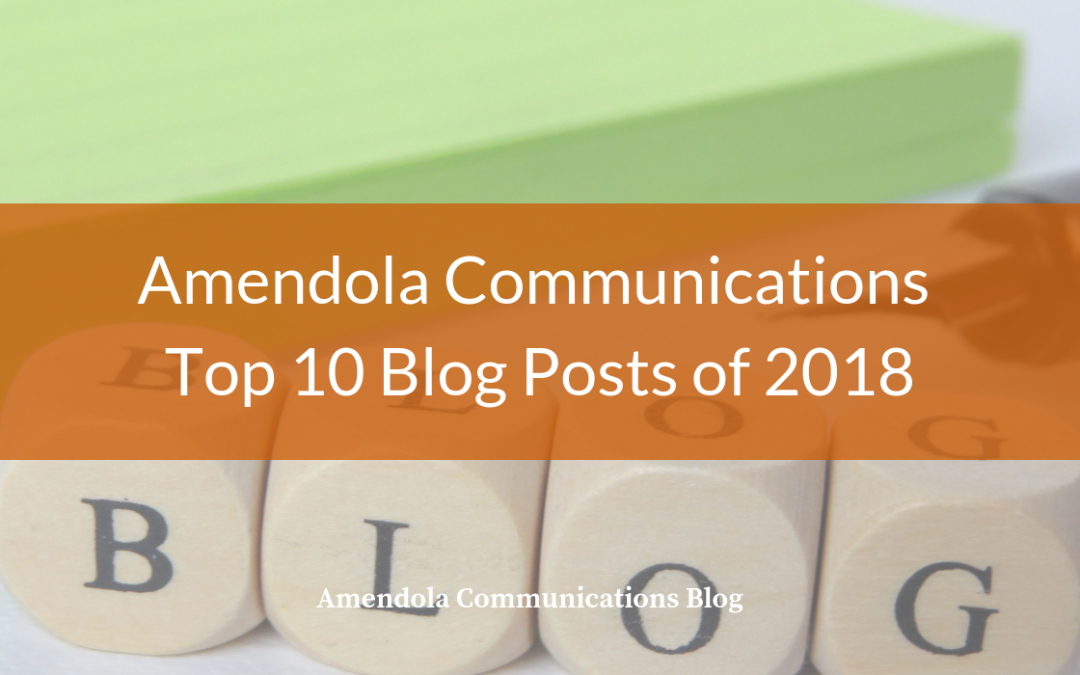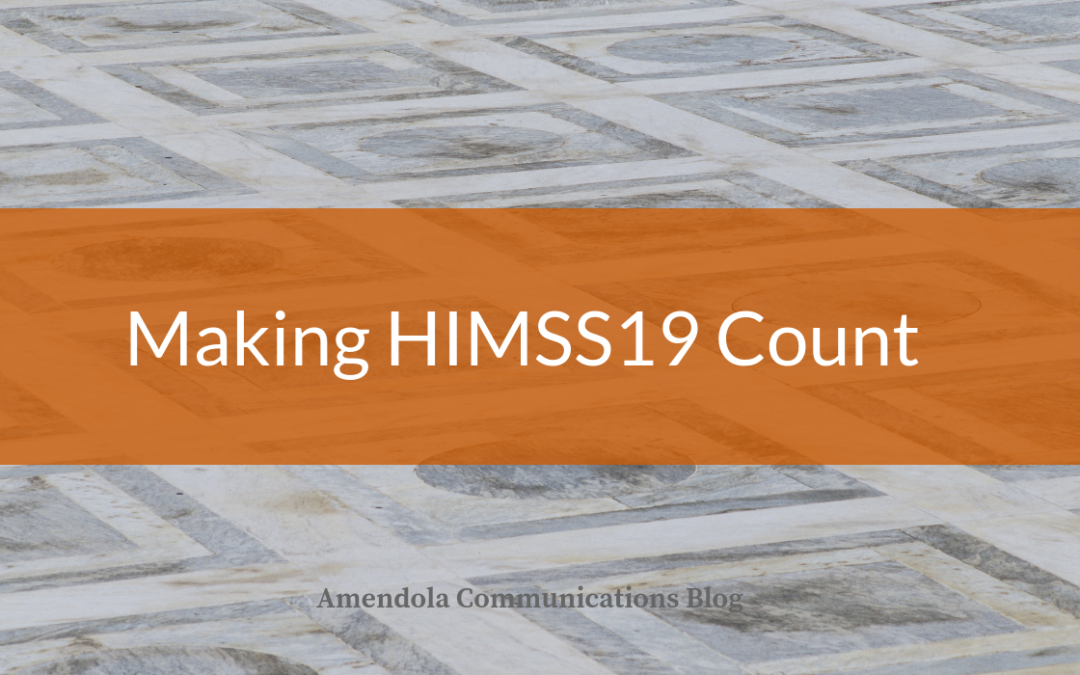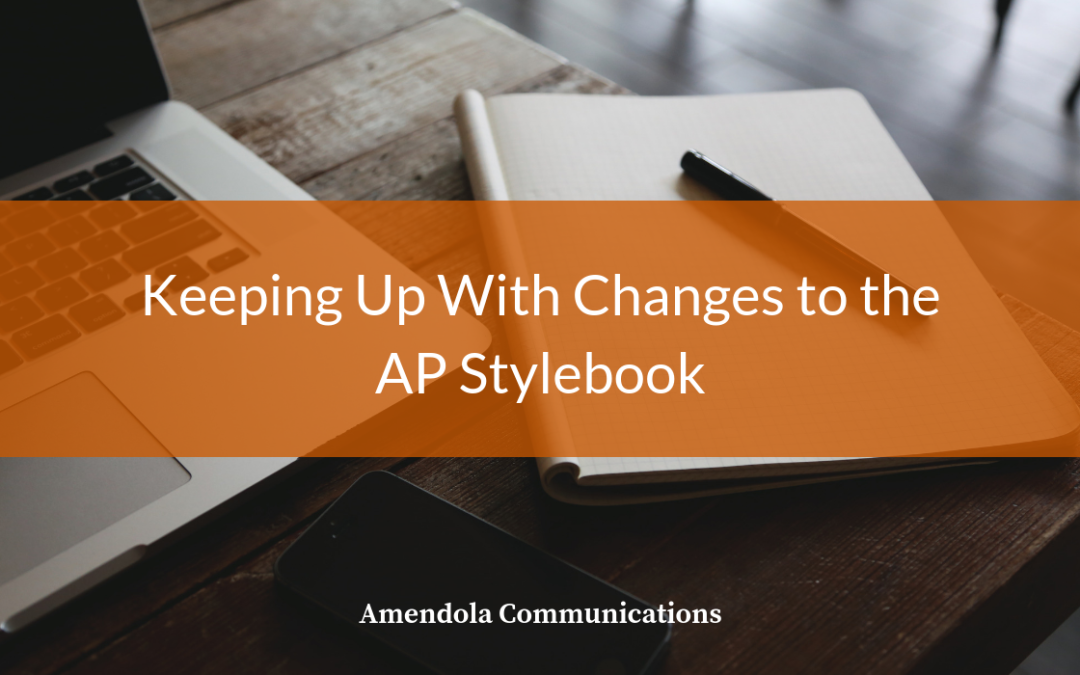
by Morgan Lewis | Jan 16, 2019 | Blog
Amendola Communications’ blog is designed to share our knowledge of public relations and marketing communications, but also to help other marketing professionals gain an understanding of how PR can and should be integrated into their campaigns. Based on our blog’s most-viewed posts of 2018, it appears readers are interested in a much broader variety of related topics, including trade show best practices, writing style tips and crisis communications.
Several of our most popular blog posts from 2018 were also re-posted on the Daily Dog site from Bulldog Reporter, which indicates that other respected PR pros thought our insights and best practices were helpful enough to share with their readers. Our most-viewed posts, however, were not all written last year. In fact, most of them were posted in 2017 and 2016. Not to get too “meta,” but that result in itself is a content marketing lesson: Valuable, relevant information never gets old.
With that, the following are the top 10 most-viewed blog posts for 2018.
10. Champing at the Bit over the Correct Use of Idioms: Its Just Good PR. For all intents and purposes, this blog post from 2016 explains the correct usage of common English-language idioms (like the one that began this sentence). Apparently, the post “piqued” a lot of readers’ interest and helped them “home in” on their key messages and “flesh out” their content you get the idea.
9. Video Blog: 5 Elements of a Successful Media Relations Program. In this vlog, also from 2016, our Media Relations Director Joy Dinaro explains how to create a successful media relations program in less than two minutes, including tips for knowing the audience and understanding vendor neutrality. Valuable insight in very little time, so it’s no wonder this post was so popular.
8. What Can We Learn From United Airlines Flight 3411. No one in PR or marketing will forget the 2017 crisis communications debacle resulting from a viral phone video of a bloodied passenger being forcibly removed from a United Airlines flight. What’s worse is United’s CEO then publicly blamed the passenger, who did nothing but refuse to give up his paid seat so the airline could give it to its own employees. Clearly, it’s still a topic of interest because this post from 2017 guest authored by James Foster, director of marketing at Amendola Communications’ client Vivify Health) made the top 10 again.
7. The importance of feedback in PR from media, to writing to client relationships. PR and marketing professionals are often so focused on daily tasks and client strategies that we often lack the time to request or contemplate feedback from the media, colleagues, or most importantly, clients. This most-viewed post from March describes different types of feedback in our profession and why it’s so important for improving service and results for our clients.
6. 6 Tips for Making Your Customer Success Stories More Compelling. Case studies are always effective B2B content because, in short, they’re real and they work. That’s why when a case study opportunity presents itself, some marketers don’t lay the groundwork to minimize the time and inconvenience for their customer while maximizing the amount relevant information captured during the research and interviewing. This post, written in 2017, gives readers a step-by-step guide to efficiently and effectively developing the perfect customer success story.
5. PR Pros: Beware of Busywork Masquerading as “Essential Skills”. Amendola Communications is a full-service integrated marketing communications and PR agency, which means our team members wear a lot of hats. However, as this blog post from May points out, PR and marketing professionals need to understand what their most valuable and creative skills are and apply them to serve clients. Other tasks can be delegated to another team member or outsourced. Trying to deliver too many services by yourself often just increases a PR professional’s stress and reduces quality, neither of which will help the bottom line.
4. Time to turn your trade show booth from salesroom to learning lab. We assume that HIMSS18 exhibitors were looking for last-minute booth tips due to the popularity of this post, which was posted just weeks before the health IT mega-conference. Although it may be a little too late for HIMSS19, the post lays out a great conference booth and content strategy that is sure to engage attendees and help your company stand out from others on the floor.
3. Simple Language and Communication Success. Healthcare IT can be complex, but the way we write about it doesn’t have to be. This post, written in 2017, reminds marketing and PR professionals the importance of concise writing and how we should use “fifty-cent words” even when the subject matter lends itself to a lot of “five-dollar words.”
2. Advice for Journalists Considering a Career in Public Relations. Because we tend to do a lot of writing, interviewing, editing, researching, Amendola Communications has a lot of former journalists on staff. Making the switch from reporter or editor to PR professional isn’t always seamless. It’s a different mindset and culture, which this blog post written by a former journalist deftly explains.
1. Going in AP Style. Most consumer and trade publications adhere to the rules of the Associated Press (AP) Style Manual. For a PR professional, using AP style demonstrates that you are a journalism insider, which is crucial when pitching a byline article, press release, or other content that needs to be reviewed and approved by an editor. The AP style guide has quirks that many business writers aren’t familiar with if they don’t have a journalism or PR background. The most-viewed Amendola Communications blog post from 2018 covers many of the most common AP-style errors even the seemingly arbitrary way it abbreviates state names. What could be a very dry topic is actually a fun, lighthearted, engaging read, which is likely another reason why it’s the most viewed post of last year.
That’s our top 10 from 2018. In all, it’s a diverse collection of posts reflecting the broad range of integrated services offered by PR and marketing professionals today, including here at Amendola Communications. We expect to see some of these posts again on next year’s top 10 list, but we will nonetheless continue to supply new enlightening and engaging PR and marketing communications insight to this page every week. Stay tuned.
Have a great 2019!

by Matt Schlossberg | Jan 9, 2019 | Blog
This year’s HIMSS Annual Conference & Exhibition (aka HIMSS19) in Orlando will be my eleventh seven as a HIMSS staffer and four as a public relations liaison for vendor clients. The HIMSS Annual Conference has become the NFL of health IT there is no real offseason and it gets bigger every year.
For the past several years, HIMSS has regularly attracted more than 45,000 attendees and 1,500 health IT vendors from around the globe.
If it sounds massive and daunting that’s because it is. If you were to visit every booth in the cavernous exhibit hall for only 10 minutes, it would take you 168 hours non-stop seven full days to complete your mission. Some attendees have complained that the show has suffered from the sprawl, while others view it as a cornucopia of selections that can be personalized to suit specific needs.
For vendor exhibitors, HIMSS represents one of the year’s most significant challenges for event planners, marketers and public relations professionals. Exhibiting companies invest an insane amount of money (and it’s a lot of money) and time (lots of that, too) in making the show a success.
There is certainly a lot of low-hanging fruit to increase your visibility at HIMSS19: Thoughtfully incorporate HIMSS19-branded social tags into your social strategy; develop a content calendar specifically for the show; and promote HIMSS19 tools like the mobile app HIMSS Circles that attendees can leverage to find your booth and education sessions.
That’s all great. However, the focus of this post is on a rather under-reported challenge most exhibitors will face separating the “tourists” from quality business leads.
Tourists are those herds of non-decision makers, culled from the unending flow of foot traffic, who visit your booth largely to acquire food, drinks and/or a free keychain. They also absorb an inordinate amount of your sales staff’s time the same sales staff who ate up a huge chunk of your budget in travel, lodging and registration fees to rope in new business prospects.
You are never going to completely eliminate tourists, but there are some useful strategies that can both slow the flow of the uninterested and attract the demographic population that is more seriously interested in your solutions.
Identify Your Targets Early. Generating quality business leads requires outreach well in advance of the show. One of the recommendations we pound into first-time attendees is the importance of creating and keeping a schedule to avoid mission creep. With all the exhibits, education and networking events to say nothing of all the stop-in-chats with peers in the hallway, HIMSS can be very distracting. Schedules fill up quick, so it’s important to connect with your leads as soon as possible. Consider investing in the HIMSS attendee list (not cheap) or utilizing a native or other third-party list to get leads scheduled to visit your booth. This also allows your staff to prioritize interested parties over passers-by.
Schedule Education and Demos. Are you noticing a scheduling theme here? I’ve noticed a number of vendors running little demos on an endless loop. They don’t seem to ever attract much attention. Instead, consider hosting scheduled education sessions and demos at your booth. Why? Scheduled demos can be easily promoted both before and during the show, making it easy for attendees to schedule time for a full presentation. Incorporate show-time signage into your booth. Speakers should be equipped with an A/V system, so a large group of attendees can see and hear everything you say. You should also film your presentation for distribution in press releases and social channels after the show, to reach an even bigger audience.
Hire a Tourist Wrangler. Reserve your most knowledgeable staff to handle serious prospects. Use lower level staff to handle visitors who may only be interested in asking a few perfunctory questions in order to obtain your swag. If a tourist turns out to be a legitimate lead, escalate them to the sales staff.
You are never going to completely eliminate tourists, but these strategies that can both slow the flow of the uninterested and attract the demographic population that is more seriously invested in exploring your solutions.

by Megan Smith | Jan 2, 2019 | Blog
I have a confession. I truly believe in the underlying meaning of cliches: What doesn’t kill you makes you stronger. All that glitters isn’t gold. Read between the lines.
But my favorite is that content is king. To me, the content and the strategy for leveraging it make or break a campaign in a heartbeat. You can have the best survey results in the world, but without a thought through and well-defined content strategy behind it, that survey will not help your business objectives.
For years, I have loved the challenge of determining how we can use the messages in a planned piece for email, visuals, paid placements, microsites, press releases, media interviews, roundtables and more. A good campaign is an integrated one where all of the pieces play off of each other. But how do you even start to plan such a campaign? In my experience, good content strategy that results in a truly integrated campaign follows the same process each time.
Establish a goal for the content With any campaign, you need to know what you are trying to accomplish and how are you going to measure success. Are you trying to get new leads? Is your goal to gain share of voice in the media in a new vertical? Do you want potential investors to see how you are filling an industry gap so that they will consider being part of your next round of funding? Once you determine the marketing goals, you can determine what type of content to create.
Focus on addressing a concern for your target market With a goal established, you should know better who you are targeting. Let’s assume that you are a revenue cycle management (RCM) vendor that has traditionally been in the hospital space but are now moving in physician practices this is a fairly crowded market so you need to focus on cutting through the noise. To do that, you know that physicians want more information about time to collections and data on the increase in patient self-pay and how that is impacting their bottom line. This will be the central theme of your content.
Define the seminal piece of content that you will create If we continue with the RCM idea above, you may create a survey about the impact patient self-pay has had on the bottom line for physician practices. Then you can create a report on the results that leverages visuals and analysis. It is critical to understand what the first piece of content you will create will be you will need to focus on creating that so that other content can spin off it easily
Let your imagination go wild with how you can use that content Now that you know that you are creating a report based on survey results, take time to think through how it that will be further leveraged. In addition to the traditional press releases and byline articles about the results, some potential options include:
- Media interviews with embargoed pre-pitching to key media so that you generate a buzz
- Email campaigns to potential leads to show the data that you have collected
- Sponsorships on industry websites this could include “gating” a version of the content to get new leads (people interested in the content provide their name and contact information to qualify for access)
- Paid digital ads that point back to your website for further leads using Google ads, LinkedIn promotions and more, you can accurately target prospects who may be searching for your content
- An interactive microsite that highlights the data that can drive retargeting efforts
- Layout a timeline of when all the content can be created and disseminated Once you confirm the exact content you will produce, it is time to create a development and dissemination timeline. At the launch of a campaign, you need to know exactly when content will launch this would include the seminal piece and the initial promotional pieces such as a press release, social content, email blasts. You can then divide the paper into snackable visuals and create infographics, articles and sponsored content so that can continue to capture leads. The goal will be to continue to provide fresh insights or analysis of the data that will encourage people to download the paper and fodder for the digital team to use for paid marketing. But you must have a calendar of when each piece and each channel will be engaged to keep the campaign on track.
- Measure, measure, measure As you did in the beginning, you should have established how you will measure success. Whether that is new leads, greater share of voice or other metrics, you need to start measuring sooner than later so that you know what channels are or are not working. So set a standard process for reviewing metrics and making tweaks to the entire plan.
By following these steps, you will be well positioned for a strong integrated marketing campaign that leverages the value of your content and thought leadership.

by Philip Anast | Dec 19, 2018 | Blog
In Stephen Ambrose’s book “Undaunted Courage,” readers learn about the courageous Lewis and Clark Expedition, and the advanced planning and preparation that went into such a grand, historic adventure. It got me thinking just how important a fraction of such planning is for a client’s public relations program.
Depending on the nature of the agency/client relationship, PR plans can go many different ways.
But there are some key objectives necessary for every plan. They include:
- Setting the parameters of a PR program and the appropriate expectations of results with clients
- Providing guidance on program priorities
- Establishing a roadmap for tactical execution
Usually, the account executive spearheads the development of a plan in conjunction with other members of an account team, and certainly with the insights of the client’s PR and marketing leads.
From my perspective, each PR plan should be original to a client, given its circumstances, yet still draw upon the best practices of the agency.
Furthermore, the account executive should confirm the form-factor of such a plan. Is a narrative proposal in Word, a PowerPoint presentation, or an Excel spreadsheet with tabs the best way to communicate the agency’s thought process? Ask your client before embarking on one vs. another.
It should go without saying, but any plan should be built on sound research, outlining key issues and trends related to a client’s business and market space, and include target audiences, competitors, and influencers. Brainstorming among client team members is one effective way to generate fresh ideas, and to develop strong communication goals, strategies and tactics in support of the client’s overall business objectives.
A detailed PR plan should consider the following program elements:
- Situational analysis
- Share of voice and social amplification
- Influencing the influencers
- Target verticals
- Target audiences
- Business goals
- Communication goals
- PR strategies and recommendations
- PR tactics (may include such things as editorial calendars, and speaker, award and event research based on the program’s direction)
- Target influencers (media and others)
- Budget
- Calendar of activities
- PR metrics
- Any optional program elements for client consideration, such as analyst relations
At its heart, a PR plan establishes the communication objectives, strategies and tactics toward reaching a client’s business goals. Such materials are crucial to ensuring that all key constituencies from executives to line-of-business and marketing leaders are aligned with the direction of the program. Such a plan serves as a beacon, and ensures that everyone agrees with the program’s elements, metrics, budget and results.
And much like Meriwether Lewis, William Clark and the Corps of Discovery, achievements will be celebrated.

by Brandon Glenn | Dec 12, 2018 | Blog
While every tool in the PR arsenal from press releases to bylines offer value in generating attention, a strong case study has the potential to stand above the rest as a real-world example of how a vendors’ product helped a customer solve a vexing business problem.
A strong case study can help a company begin to move beyond talk to illustrate action specifically the positive outcomes, enhanced revenue or cost savings a prospect can achieve by taking the action of implementing your product. Customers want to know you have experience solving problems just like the ones their company is currently experiencing, and a case study provides the perfect opportunity to demonstrate exactly what your company and product accomplished to deliver value to a similar organization.
A well-executed case study must tell a story. In this story, the hero is the customer that boldly and courageously implemented your product to better serve her own patients or customers. The vendor plays the role of the humble servant, providing support and guidance to help the hero accomplish her goals and save the day.
In its most basic form, a case study’s story consists of “Problem -> Solution -> Results” but a strong case study requires more. Think of it as a job interview in which your primary challenge is to convince a prospect why your product is the one she should hire for the position.
When developing your next cast study, be sure to include these four essential elements:
- Customer quotes: Don’t just tell us how the customer feels about your product, show us by using the customer’s own words. A customer’s own words always carry more weight and create a greater impact than what a vendor says about its own solution. The best way to obtain valuable quotes is to interview end-users of the product.
- Quantified results: Nothing is more demoralizing for a case study consumer than to feel interest and curiosity while reading through the introduction, problem and solution sections, only to come to a disappointing results section that contains vague language of improvement and no key metrics. It’s a sure way to turn off a prospect who was beginning to consider your solution. After implementation, did your solution help the customer make money, save money, see more patients, or improve operations in some other quantifiable way? Let us know about it in as much detail as possible. While some customers are understandably reluctant to share specific dollar amounts, they’re more likely to approve of using percentages, such as “grew revenues 50 percent one year after adopting the solution.”
- What’s next: It isn’t lost on most people that a case study must include detailed information on how a customer has already used a vendor’s solution, but it’s easy to forget to include details about future plans. Does the customer plan to expand use of the solution with a new patient population, offer it at a new location or purchase a complementary product? Including this information will help prospects conceive of a long-term strategy for their adoption of your product.
- Call to action: Another easy-to-forget aspect of a case study is the call-to-action (CTA), which provides the vendor with an opportunity near the end of the piece to request a specific action from the reader. Whether you’re offering the reader more content to consume or a free giveaway, or asking them to fill out a form, be sure to make the experience as easy as possible for the user to complete.
Wherever your latest prospect is in the customer journey, a solid case study holds the possibility of providing that nudge to take the next step. When you sit down to plan out your next customer case study, don’t forget these four essential elements.

by Ken Krause | Dec 5, 2018 | Blog
The writing “Bible” for public relations is the AP stylebook. Anytime a PR professional (or anyone writing for media publication for that matter) is unsure of what to do, such as whether to capitalize an executive’s title in a press release, a quick glance at the print or online version will provide the correct answer. (For the record, the answer is “no” as this blog post points out.)
This reliance on the AP stylebook can lead one to think that its rules are all set in stone. But one would be wrong, as the post, “10 Recent AP Stylebook Changes and Reminders You Should Know About,” from Cision points out.
Whether you are debating whether the correct spelling for a particular type of wine is syrah or shiraz, wondering whether someone who uses the emergency department a lot should be labeled a frequent flyer or frequent flier (the former is correct), or how to use a number in a headline (use numerals for all, even though in the body you write out one through nine and then go to numerals from 10 on), the AP stylebook has the answers. And it’s continually being adjusted, so don’t assume!
To make sure you’re on top of your AP stylebook game, be sure to check out the full post here.





